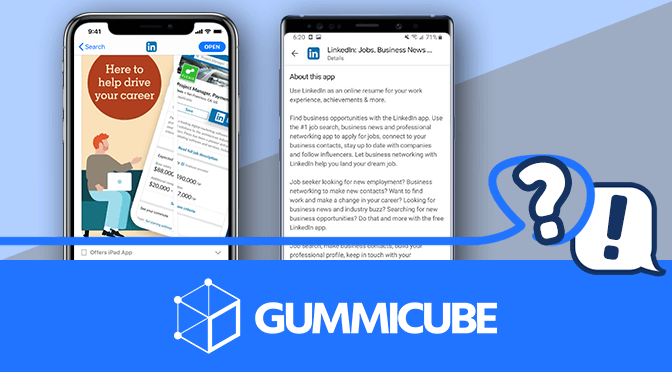App Descriptions Best Practices
May 7th, 2020

App descriptions are essential for App Store Optimization and conversions. They tell users what an app has to offer, why they should download it and how it can help them. Additionally, they provide valuable data to the App Store and Google Play Store that can be used for paid campaigns and indexation. If you want to create app descriptions that can help improve conversions and help with your App Store Optimization, here are some best practices to follow.
General Best Practices
When writing app descriptions, developers need to consider the stores that the app is available on. Each store has different guidelines and best practices, but there are some that are universal.
1. Compliance
All descriptions must be fully compliant with the guidelines for the respective store. This can include:
- In-app purchases or subscription information and policies
- Copyrights and licensing
- Legal information and disclaimers
Failing to include these can result in the app being rejected altogether. As such, developers should fully understand what the policies are for each store and ensure their descriptions are compliant.
2. Length
Both stores allow a maximum of 4,000 characters for the description. Any legal text such as purchase information, copyright information and so on is counted in those 4,000 characters. Line breaks and spaces are counted, which some character counting tools can miss.
3. Introduction
The description should reinforce the value of the app. Beginning with a strong introduction that includes a value proposition can help your app start off on the right foot. Users want to instantly know what sort of app they’re looking at and what it can do for them.
The introduction should cover what an app does, how it can help and who it’s for. This is a good place to include pertinent information and core values. For instance, mobile games can include information such as the story, characters and type of gameplay. Photography apps, as another example, can cover information like how helpful it is for amateur or expert photographers and the types of editing effects users can get.
4. Feature Sets
After the introduction, the description should include feature sets. These are bulleted lists delving into specific features. It is recommended to use multiple sets based on different features or values, then each bullet point can cover various aspects.
This allows users to glance through the description and find information pertinent to their needs. Using bold or capitalized text at the start of each feature set can make it easier for them to catch the eye.
5. Keyword Usage
Descriptions should also incorporate keywords. This serves a variety of purposes. For Google Play apps, the algorithm crawls the description for keywords the app can potentially index for. For iOS apps, keywords are used for determining relevance for Apple Search Ads. No matter which store, including keywords helps connect the app to user queries. If users can quickly see how the app relates to their search query, they’re more likely to convert.
Remember that users typically scroll through descriptions to learn what they can at a glance. Important information should be easy to spot. Burying key information in the middle of a paragraph all but ensures users will miss it.
Apple App Store Descriptions
On the Apple App Store, app descriptions should utilize short lines that are easy to read on iPhone devices- a factor that can be overlooked when writing a description on a desktop text editor. These should be no more than 3 sentences long, so users can read them while scrolling down the screen. Anything more forms a large block of text on the phone screen that users are less likely to read.
App Store descriptions can also begin with Promotional Text. This is an extra 170 characters that can appear at the top of the app description and can be edited at any time. You can use the Promotional Text to call out special offers, limited time events, seasonal changes and so forth without needing to launch an update.
Apple does not enable HTML for its descriptions, so descriptions cannot use bold text, italics, colors or other similar effects.
Incorporating keywords does not help with keyword indexation, but as mentioned above, it does help build relevance for Search Ads. Incorporating the keywords that you’re targeting in an Apple Search Ads campaign can indicate to both potential users and the Search Ads algorithm that the app is relevant to the terms you’re bidding on.
Apple provides several description guidelines and suggestions, including:
- Don’t add unnecessary keywords to improve search results
- It is recommended to include accolades at the end of the description
- Do not directly target competing brands
- Indicate if any additional purchases are required and for what features
- Be clear about subscription information
Google Play Descriptions
Google Play descriptions are different from Apple App Store descriptions in several ways. The most important distinction is in how keywords are used.
While iOS apps have declared boxes for keywords, Google Play determines keywords for an app by crawling the description. As such, it is essential for the description to integrate keywords in a visible manner. This can be done by utilizing them organically while describing the app and in the feature sets.
At the same time, it is important to avoid keyword stuffing. The Google Play Developer Policy makes a point to call out metadata violations, including:
- Word blocks and long word lists designed solely for keyword purposes
- Comparison to competing apps or brands
- Unattributed or anonymous user testimonials (properly attributed testimonials are allowed)
- Inappropriate language
Unlike the iOS App Store, Google Play allows the use of basic HTML markup. This means that descriptions can include text effects such as different colors, bold text and so forth. These can be used to emphasize certain keywords or highlight the headers for feature lists to make them easier to notice.
Using emoji can also help catch the user’s eye or adjust the tone for app descriptions on Google Play. This can be helpful for apps such as social network or chat apps, mobile games or apps for children. Developers can consider testing app descriptions with or without emoji to see what appeals to their audience the best.
When Google Play Store descriptions are viewed on mobile devices, users will see a Short Description first. This is an 80-character introduction that should provide the core value and pertinent information. Clicking on “See More” will reveal the Long Description.
Overall
Good app descriptions can convince users to convert and show them all the benefits of the app. Additionally, descriptions can have an important impact on how the app is indexed for Google Play keywords or viewed by Apple Search Ads.
While there are some best practices for descriptions overall, it’s also important to know how the App Store and Google Play Store differ. Writing distinct descriptions for each store is essential, as what works well in one may be detrimental to the other.
With a well-written description, users will know exactly why they should download your app and what they’ll get from it.
Want more information regarding App Store Optimization? Contact Gummicube and we’ll help get your strategy started.

